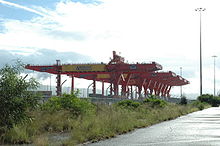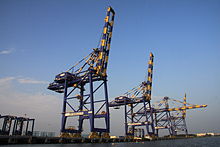- Container crane
-
A container crane (also container handling gantry crane, ship-to-shore crane ) is a design of large dockside gantry cranes found at container terminals for loading and unloading intermodal containers from container ships.
Container cranes at Kochi
Container cranes consist of a supporting framework that can traverse the length of a quay or yard, and a moving platform called a "spreader". The spreader can be lowered down on top of a container and locks on to the container's four locking points ("cornercastings"), using a "twistlock" mechanism. Cranes normally transport a single container at once, however some newer cranes have the capability to up pick up up to four 20-foot containers at once.
Contents
Types
There are two common types of container handling gantry crane: high profile where the boom is hinged at the waterside of the crane structure and lifted up in the air to clear the ships for navigation; the second type is the low profile type where the boom is shuttled/pulled towards and over the ship to allow the trolley to load and discharge containers. Low profile cranes are used where they may be in the flightpath of aircraft such as where a container terminal is located close to an airport.
Sizes
 Super-PostPanamax cranes in Port of Rotterdam, these overhang by 50 m (22 rows of containers).
Super-PostPanamax cranes in Port of Rotterdam, these overhang by 50 m (22 rows of containers).
Container Cranes are generally classified by their lifting capacity, and the size of the container ships they can load and unload containers.
- Panamax
- A "Panamax" crane can fully load and unload containers from a container ship capable of passing through the Panama Canal (ships of 12–13 container rows wide).
- Post Panamax
- A "Post-Panamax" crane can fully load and unload containers from a container ship too large (too wide) to pass through the Panama Canal (normally about 18 container rows wide).
- Super-Post Panamax
- The largest modern container cranes are classified as "Super-Post Panamax" (for vessels of about 22 container rows wide and/or more). A modern container crane capable of lifting two (2) 20-foot (6.1 m) long containers at once under (end-to-end) the telescopic spreader will generally have a rated lifting capacity of 65 tonnes. Some new cranes have now been built with 120 tonne load capacity enabling them to lift up to four (4) 20-foot (6.1 m) long or two (2) 40-foot (12 m) long containers. Cranes capable of lifting six (6) 20-foot-long containers have also been designed. Post-Panamax cranes weigh approximately 800–900 tonnes while the newer generation Super-PostPanamax cranes can weigh 1600–2000 tonnes.
Operation
 All of the containers on Rita have been loaded by similar cranes to this one in Port of Copenhagen
All of the containers on Rita have been loaded by similar cranes to this one in Port of Copenhagen
 A MAN AG container crane belonging to Patrick Corporation at Port Botany, New South Wales, Australia.
A MAN AG container crane belonging to Patrick Corporation at Port Botany, New South Wales, Australia.
The crane is driven by an operator that sits in a cabin suspend from the trolley. The trolley runs along rails that are located on top or sides of the boom and girder. The operator runs the trolley over the ship to lift the cargo which generally are containers. Once the spreader latches (locks) on to the container with the Spreader, the container is lifted and moved over the dock and placed (discharged) on a truck chassis (trailer) to then be taken to the storage yard. The crane will also lift containers from the chassis to store (load) them on to the ship.
Straddle carriers, sidelifts or container lorries then manoeuvre underneath the crane base, and collect the containers—rapidly moving the containers away from the dock and to a storage yard.
Power
The cranes are often powered by two types of Power Supply; by diesel engine driven generators which are located on top of the crane or by electric power from the dock. The most common is by electric power from the dock (also known as shore power) The AC Electric power transmission source can range from 4,000 up to 13,200 volts, but is not exclusive.
History
Cranes were used in harbors starting in the middle ages – see crane: harbor usage and list of historical harbour cranes. Modern intermodal containerization emerged in the mid 1950s, emerging from transport strategies developed in the Second World War and the Korean War, and specialized cranes parallelled developments in containerization.
In popular culture, container cranes are occasionally called AT-AT cranes due to their resemblance to AT-AT walkers in George Lucas's Star Wars films, although Lucas denies their inspiration[1] .
See also
- The Box (BBC container)
References
- ^ Hartlaub, Peter. "Nah, dude, they weren't cranes". San Francisco Chronicle. http://www.sfgate.com/cgi-bin/article.cgi?f=/c/a/2008/06/25/DDMH11DRSK.DTL.
External links
Intermodal containers Overview 
Transport Handling Container terminal · Container crane · Reach stacker · Rubber tyred gantry crane · Sidelifter · Straddle carrier · TwistlockTypes Refrigerated container · SECUOther Container crane · Crane vessel · Gantry crane · Level luffing crane · Sidelift · Straddle carrier · Tow truckCategories:- Commercial item transport and distribution
- Cranes (machines)
- Intermodal containers
- Port infrastructure
Wikimedia Foundation. 2010.


